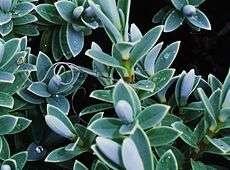Mermithidae
| Mermithidae Temporal range: Aptian – Recent | |
|---|---|
_-_Body.png) | |
| Mermithid from Asian Hornet | |
| Scientific classification | |
| Kingdom: | Animalia |
| Phylum: | Nematoda |
| Class: | Adenophorea |
| Subclass: | Enoplia |
| Order: | Mermithida |
| Family: | Mermithidae Braun, 1883[1] |
Mermithidae is a family of nematode worms that are endoparasites in arthropods. As early as 1877, Mermithidae was listed as one of nine subdivisions of the Nematoidea.[2] Mermithidae are confusable with the horsehair worms of the phylum Nematomorpha that have a similar life history and appearance.

Mermithids are parasites, mainly of arthropods. Most are known from insects, but some are recorded from spiders, scorpions and crustaceans. A few are known to parasitize earthworms, leeches and molluscs,[3] and a specimen is known from a spider preserved in forty-million-year-old Baltic amber.[4]
At least 25 species are known to parasitize mosquito larvae, making them of considerable interest in biological control.[5]
A species, probably Pheromermis vesparum, was recorded from the invasive Asian hornet (Vespa velutina) in France. The parasite was considered to be a member of the local fauna which had adapted to a new host. However, the authors concluded that the mermithid could not hamper the hornet invasion nor be used in biological control programs against this invasive species.[6]
Life history
Mermithids are wire-like and have a smooth cuticle with layers of spiral fibres. The digestive tract is similar to that of free-living nematodes only in the young larvae prior to their parasitic life; in the parasitic stages the oesophagus is disconnected from the mid-intestine, and females lack an anus. The female genital opening is at the midbody, while the male opening is at the tip and visible as one or two spicules. The eggs are laid either in water or on land, and the newly hatched larvae are free-living, as are the adults that emerge from the hosts to lay eggs.[7]
The taxonomy of the group has been confused due to poor specimen collection as well as very limited morphological characteristics, and most are discovered by entomologists rather than nematologists. Even the best-studied species, Romanomermis culicivorax, has an unclear taxonomic status.[8]
References
- ↑ Braun, M. (1883) . Die tierischen Parasiten des Menschen nebst einer Anleitung zur praktischen Beschäftigung mit der Helminthologie fur Studierende and Ärzte.
- ↑ Lankester, Professor (1877). "Subdivisions of the Nematoidea". Quarterly Journal of Microscopical Science. Clarendon Press. 17: 449. Retrieved 27 November 2008.
- ↑ Poinar, G.O. (1985). "Mermithid (Nematoda) parasites of spiders and harvestmen" (PDF). Journal of Arachnology. 13 (1): 121–128.
- ↑ Poinar, George (2005). "Heydenius araneus n.sp. (Nematoda: Mermithidae), a parasite of a fossil spider, with an examination of helminths from extant spiders (Arachnida: Araneae)". Invertebrate Biology. 119 (4): 388–93. doi:10.1111/j.1744-7410.2000.tb00108.x. JSTOR 3227190.
- ↑ Platzer, EG (1981). "Biological control of mosquitoes with mermithids". Journal of Nematology. 13 (3): 257–62. PMC 2618106
 . PMID 19300759.
. PMID 19300759. - ↑ Villemant, Claire; Zuccon, Dario; Rome, Quentin; Muller, Franck; Poinar, George O.; Justine, Jean-Lou (2015). "Can parasites halt the invader? Mermithid nematodes parasitizing the yellow-legged Asian hornet in France". PeerJ. 3: e947. doi:10.7717/peerj.947. PMC 4451032
 . PMID 26038716.
. PMID 26038716. - ↑ Rubzov, 1. A. (1972). "Aquatic Mermithidae of the Fauna of the USSR", Vol. 1. (Zoological Institute, Academy of Science USSR).
- ↑ Petersen, J.J. (1985) "Nematodes as biological control agents: Part 1. Mermithidae", pp 307–344. In: Baker, J. R. & Muller, R. (eds). Advances in Parasitology. Academic Press, London.
External links
- Nickle, WR (1972). "A Contribution to our Knowledge of the Mermithidae (Nematoda)". Journal of Nematology. 4 (2): 113–46. PMC 2619923
 . PMID 19319257.
. PMID 19319257. - Biological control potential
- http://flnem.ifas.ufl.edu/HISTORY/entomophilic_history.htm
- http://www.uel.ac.uk/mosquito/issue10/mermithids.htm
- Mermis nigrescens on the UF / IFAS Featured Creatures Web site